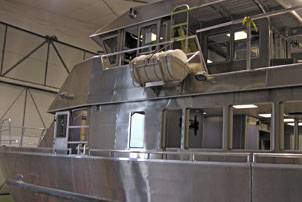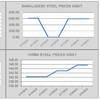Why Do New Boats Cost So Much?
With the economy as it is, one might expect to be able to walk into any shipyard, name your price and have construction of a brand new workboat commence instantaneously. While every shipyard is eager for new business, work is still coming in slowly and fairly steadily. As for price, now is a great time to buy, but don’t expect the deal of the century. Current prices for raw materials seem to mimic the price levels of nearly five years ago, but component and equipment pricing are still stuck in an inflationary pattern, increasing nearly four to 7 percent per year. More stringent environmental regulations, increased safety standards, and additional accessibility considerations will also start piling onto the bottom line. Operators should closely consider the opportunity to add to or upgrade their fleet now before pricing starts to really get expensive.
Some new customers experience sticker shock when they receive preliminary price estimates on construction of a new vessel. Pricing should be straight-forward, and generally speaking, is a direct sum of man hours, material costs, and mark-up. In our workboat industry we deal almost entirely with custom-designed and custom-built vessels. A builder assumes a certain amount of risk each time a new custom vessel is quoted, designed, and constructed. The risk of the unknown is borne with a small premium. Pricing would surely be simpler and more competitive if custom craft could be ordered via an a la carte menu and assembled with Lego-like components that are snapped together in virtually any conceivable combination. Builders can really fine tune their bids when potential customers request sister ship pricing. Unfortunately, the term sister ship is usually only a temporary adjective as change requests for two more feet of beam, slightly different engines, and the addition of one extra head start to emerge on the general arrangement drawings. At this point, the builder will have to create new drawings, incorporate new engineering, and undertake a completely new bid estimate.
Those considering a new purchase should be aware of the “$27,000 sliding window effect” when requesting specific items to be quoted for their custom vessel. A customer once made a simple request to modify the construction specification and have a single sliding window added in the main cabin where only direct-glazed windows were set to be installed. Simple enough, the cost differential should just be a matter of calculating added labor and materials. With further consideration, not only did the additional window directly increase the materials costs, but the impact of an open window altered the heat gain and loss calculations, which ultimately necessitated a change to the heating and air conditioning system, size of the generator, and generator exhaust system, in all totaling $27,000. In boatbuilding, absolutely every material and design feature is related at some component level and will ultimately be evident in the final price and performance estimate.
Contrary to assumption, sometimes selecting the more expensive part is actually the most affordable option. The value of a premium part is realized in one of two ways. Paying more up front may yield a higher quality part and save the builder the headache and expense of a potential warranty claim. Secondly, spending more on individual parts may allow the builder to save on installation labor or even eliminate the cost of other system components. Parts may also be more expensive if they are sourced directly from foreign suppliers. Builders are sometimes forced to source key construction materials from foreign markets due to the lack of availability or competitive prices in the U.S. In these instances, builders must insulate their costs from the potential of unfavorable exchange rates at the time of purchase.
In order to get the best realized value when procuring a new work platform, clarify reasonable and practical expectations with your builder during the design and bid phase. Ask the builder to provide a detailed construction specification so there is mutual understanding as to how the boat will be built. Specifications can easily be interpreted and met in several different ways. I have seen some builders meet requirements for welded aluminum ladders by chopping up and installing segments of aluminum ladders straight off the shelf of the local hardware depot and fulfill acoustic and thermal insulation requirements by tacking carpet to the inside of bulkheads. These lower cost solutions may or may not be acceptable for some customers and applications, so take the time to understand what you are really paying for.
If you are considering construction of a new vessel in the near future, start talking to builders now. On average, a builder and potential new customer will engage in design and pricing discussions for a period of 12 to 24 months before a final contract is signed. Raw materials are currently priced at very desirable levels and one can only wait for the impact of inflation to start kicking in. The lull in the economy has created pent up demand and once again yards are starting to create wait lists and take deposits on future production slots as customers are choosing to jump in now. New construction may seem expensive but the value of a purpose-built vessel is often beyond measure. Some new vessels can even pay for themselves with better speed, fuel economy, and application-specific technology that can yield higher rates of return.
Joe Hudspeth is the Business Development Manager at All American Marine, Inc. and has over ten years of marine related experience in sales, marketing and product development. He currently serves as a regional co-chairman for the Passenger Vessel Association. He can be reached at [email protected] or 360-647-7602.














